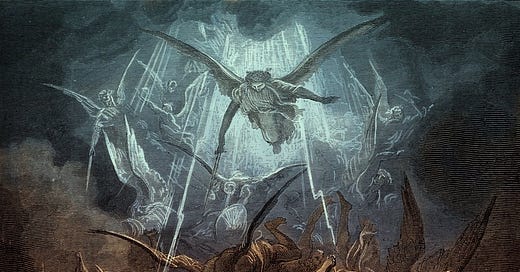If memory serves, it was in 1973 that I first became aware of the correspondence between Genesis 3:6, Luke 4:1 – 13, and 1 John 2:16. It’s not a revelation I can claim as my own. At the time, I was using an old, pocket-sized Protestant devotional, the title of which now escapes me, that grouped together Scriptural selections for each day of the year according to theme, without any accompanying commentary and not a shred of sentimentality (as, unfortunately, would be the case today). It taught me not to underestimate the sort of studious old-time exegetes who could compile such a valuable little book. With that by way of introduction, here is the connection between the three biblical texts: Beginning with the last citation, 1 John 2:16 reads: “For all that is in the world, the lust of the flesh and the lust of the eyes and the pride of life, is not of the Father but is of the world” (emphasis added). That verse is much weightier than it appears on the surface, but basically it asserts that there is a vital distinction to be made between what comes from the Father and “all” that derives from “the world.” In this instance, “world” – kosmos – is used to indicate the “realm,” both spiritual and fleshly, that resists and opposes God (see Rom. 5:10). What constitutes “the world” is: the lust (ἐπιθυμία; epithymia) of the flesh (which isn’t merely an allusion to sexual desire, but includes all forms of disordered bodily passions ungoverned by the intellect), the lust (ἐπιθυμία) of the eyes (meaning the insatiability of the greedy, lustful eye – precisely what our contemporary consumer culture exploits), and the pride (ἀλαζονεία; alazoneia) of life (which refers to showing off, outward display, and also arrogance). These three classifications correspond to the “passions” that motivated Eve, according to the story of the Garden, to partake of the forbidden fruit: “So when the woman saw that the tree was good for food [the lust of the flesh], and that it was a delight to the eyes [the lust of the eyes], and that the tree was to be desired to make one wise [the pride of life], she took of its fruit and ate; and she also gave some to her husband, and he ate” (Gen. 3:6; emphasis added). Lastly, those same categories are present in Luke’s account of the temptation of Jesus in the wilderness (Lk. 4:1 – 13; Matthew’s probably earlier ordering of the second and third temptations are reversed): first, Jesus is tempted to change stones into bread (the lust of the flesh), then he is shown the kingdoms of the world with the Satanic promise that he can have what he sees if he will render allegiance to the devil (the lust of the eyes), and finally he is challenged to perform the sensational – and public – miracle of leaping from the pinnacle of the Temple unhurt (the pride of life). Those are the correspondences between the three texts. All three speak of temptations (“tests”) targeting human passions by an “enemy” (“world,” “serpent,” “devil”): 1 John listing them bluntly; Genesis in narrative form, with the story of “Paradise lost”; and Luke, likewise narratively, with the devil vainly attempting to trip up the One who couldn’t be moved to sin (“sin,” incidentally, means to veer “off course” and to “miss the mark”). And with that, I turn to the subject I really have in mind: In all these temptations, there is at work a catalytic evil that, once given place in our hearts, has the power to generate outwardly division, corruption, and destruction. It is so “subtle” a disrupter, often presented to us in attractive or seemingly innocuous garb, that it tends for the most part to go unnoticed or is excused, except by “those who have their faculties trained by practice to distinguish good from evil” (Heb. 5:14) – those, we might say, given to watchfulness. So, what should we call the insinuating evil that demands from us such constant interior vigilance?
Keep reading with a 7-day free trial
Subscribe to The Pragmatic Mystic to keep reading this post and get 7 days of free access to the full post archives.



